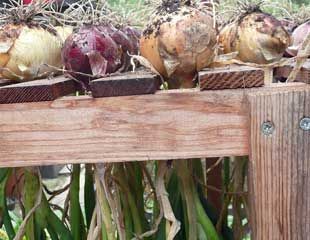


How to grow onions
I like growing onions because they are an easy crop. In a bad weather year, when growing vegetables is difficult, you can always rely on onions. One reason they are easy to grow is because they do not need a lot of water and tolerate drought and dry spells well.
The easiest way to grow onions is from sets, tiny onion bulbs that have been treated to produce good bulbs. The treatment also reduces the possibility of the onion producing a flower and bolting. Onion sets typically come in large quantities, often 50 or more in a bag, which is a large number of onions for most gardeners.It is therefore helpful to know they will keep from year to year.
Onions keep well so you can pick and use throughout the winter. Provided you store onion sets somewhere dry and cool, you can also carry over spares to the next gardening season.

Onions are very easy to grow, they almost grow themselves
How to grow and plant onions
You can plant onions in spring, March - April or autumn September-early November. You can buy onion sets that are labeled for either spring or autumn planting. You just need to check when you buy.
If your plot is well drained and the soil is not too heavy, you can plant in autumn ideally with some added organic matter. As with all bulbs, winter wet can cause the bulb to rot. To grow onions, the ground doesn't need to be really finely raked as it does for carrots and salad crops, just reasonable and not compacted. On heavy soils, it is better to plant in the spring.
Plant Onions in full sun in fertile soil which has plenty of organic matter added.
Onions are a bulb when planting the hairy bulb end goes downwards. It is best to plant with a trowel, making a small indentation in the soil. Using your finger to push the bulb in can result in damage to the hairy bulb end. Place the bulb down so only the top tip of it is showing above ground. It is important to appreciate that onions sit just under the soil with a tiny top bit pointing out of the earth. Also, if you push the bulb in, onions have a tendency to push the bulb back out again when it roots. Plant rows each about 5-10cms apart.
If you are interested in the aesthetic appearance of your veg plot, planting red and white/brown onions in patterns in rows looks attractive. Some veg plots, as seen in the show gardens such as at RHS Harlow Carr, are really inspirational. A more practical reason for planting in tidy straight rows is that you know everything outside the row is a weed which makes the weeds are easier to find and dispose of. (see best gardening tips)
A row or two of sweet peas to bring in the pollinators adds colour and looks lovely. If your garden shed is next to the veg plot, the side of the shed is an ideal place for a bit of trellis and a few sweet peas. If you have no border, use a trough and fill with rich compost as sweet peas are greedy. More about growing sweet peas
Onions are generally pest free except for......

Growing onions is easy and onions have very few enemies in terms of pests, but they have one terror; the pigeon.
The creature waddles toward the plot, pecks at the little onion sprout, and pulls the bulb out of the ground. They are a menace. If you have a lot of pigeons in your area, you will need to deter them by covering the onions with a cloche /netting, and keep some spare bulbs to replace the pigeon pecks.
Which Onions are the best onions to grow
In 2013, the RHS conducted a plant trial of onions where they tested and assessed 21 different onion types for bolting, size, and yield. They then stored 25 of each type uniformly to assess their storage quality. Following the trial, 12 onion types received the AGM award.
Following the tria,l buying onions with the RHS award, is an easy way to pick a good variety suggestions are : Red onions Marshals Red Fen, Red Baron, and Garnet. Heat treated yellow and brown skinned onions Rumba: not heat treated Sturon, Centurion, Hercules, Autumn Gold Improved, Griffon, Setton, Vulcan, and Turo.
Curiously, nearly all of the AGM were not heat-treated, and the trial suggests that it does not in practise make any difference.
Harvesting and Storing Onions
In September, the tops of the onion plant turn golden brown and look like dry growth rather than green growth. When this happens, the onions are ready to harvest. Harvest Onions on a warm day or preferably a warm spell, lift them and sit on the warm dry earth for a few days to dry out throughly and then store in a cool place in string bags.
All these references to "warm" are all very well, but our weather does not always oblige. If the weather isn't good, and you cannot dry onions outside, it is still important that onions dried before storage. If the weather is poor, another possibility is in the greenhouse where the slats make an ideal spot to dry them out for a week or so before bringing in to store somewhere light and cool. Or put into a string bag and hang up. You can dry onions, garlic and shallots in this way, as shown below. Any moisture will cause the bulb to go mouldy. Onions need to be stored in a cool light environment, an unheated conservatory, garage or porch is suitable.




